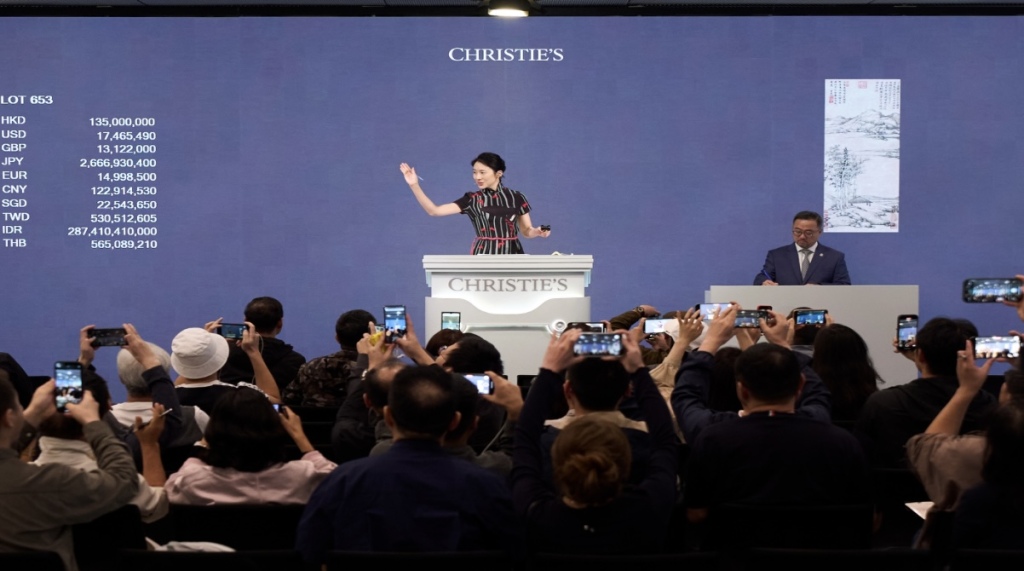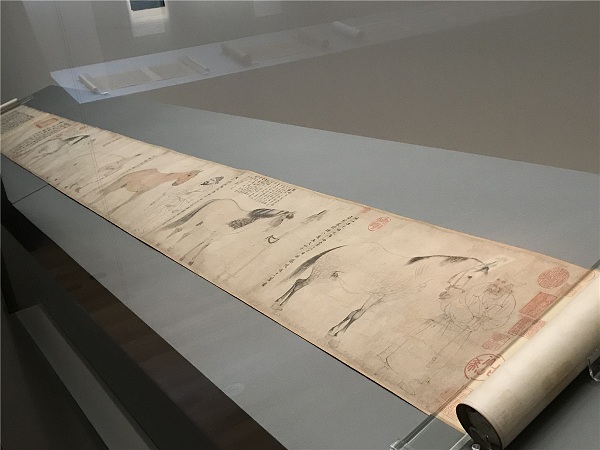
The Paper learned that since March 30, calligraphy and paintings passed down from generation to generation, such as the "Sketch" volume of Song Dynasty Fachang, Yuan Dynasty Ni Zan's "Maple Falling Wujiang Map", and Wang Meng's "Autumn Mountain Thatched Cottage" scroll, have been exhibited at the National Palace Museum in Taipei. out. The exhibition titled "Painting, Song, Ink and Dance - Guided Appreciation of Paintings at the National Palace Museum in Taipei" has selected more than 20 calligraphy and painting works from the Five Dynasties and the Southern Tang Dynasty to the Qing Dynasty, covering subjects such as figures, flowers and birds, and landscapes. The exhibition will last until June 25 .
It is said that the "Sketching" volume of Fachang in the Song Dynasty is an imitation of Fachang's ink play. The sketches of objects seem random, but each flower and leaf are delicate and vivid; The rocks on the slopes are depicted with a pen that turns from the center to the side, creating a sense of rock faults. In the middle, I feel that it is ancient, thick and clear.
(Biography) Song Fachang’s sketchbook (partial)
The development of ancient paintings is like a wonderful symphony. With the typical styles of figures, flowers and birds, landscapes and other painting subjects, several important themes are composed, and variations are made in the historical context.
The model of figure painting was gradually established by Gu Kaizhi, Wu Daozi and others during the period from the Six Dynasties to the Tang Dynasty (222-907). The canon of landscape painting was formed around the time of the Five Dynasties (907-960), and it contained the characteristics of geographical regions. For example, Jing Hao and Guan Tong painted the landscapes of the north, while Dong Yuan and Ju Ran had the characteristics of the landscapes of the south of the Yangtze River. In terms of flower feather painting, Huang Quan from Sichuan and Xu Xi from Jiangnan also formed two different models.
Fan Kuan, Guo Xi, and Li Tang in the landscape paintings of the Song Dynasty (960-1279) all innovated on the basis of existing models and became new models. Under the advocacy of the art emperors of the Song Dynasty, the Palace Painting Academy developed an unprecedented grand occasion. The painters at that time paid attention to the observation of nature, and added "poetry" to enhance the connotation and artistic conception of paintings. The interest in real objects led to the painting types of buildings, boats and cars, etc., which were mainly mechanical structures, which made them leap onto the stage of painting after the eleventh century. With emphasis on poetry, albums with calligraphy, poetry, and painting were developed in the Southern Song Dynasty. In addition, the literati in the Song Dynasty also extended the concept of artistic expression to categories other than "similarity", and literati painting began to become a new style.

The exhibition site of Wang Meng's "Autumn Mountain Thatched Cottage" axis in Yuan Dynasty
The literati paintings of the Yuan Dynasty (1279-1368) were marked by retro styles by Zhao Mengfu and the Four Great Masters of the Yuan Dynasty (Huang Gongwang, Wu Zhen, Ni Zan, and Wang Meng). These styles gradually became important models in the development of painting, and maintained a continuous influence after the Ming and Qing Dynasties.
After the Ming Dynasty (1368-1644), the styles and characteristics of different regions became an important link in the development of art. Suzhou's "Wu School" evolved elegant literati styles from the four great masters of the Yuan Dynasty, and the "Zhe School" mainly composed of Zhejiang and Fujian painters developed from court paintings, turning the models of the Southern Song Dynasty into extensive ink and wash. Dong Qichang in Songjiang and later Wang Shimin, Wang Jian, Wang Hui and Wang Yuanqi and others continued to recreate nature with brush and ink in the "collection" of ancient models, forming a far-reaching "orthodox school".
The emperors of the Qing Dynasty (1644-1911) not only admired the "orthodox" style of painting, but also tolerated the Western painting methods brought by European missionaries. Three-dimensional and perspective became new interpretations of ancient models. In Yangzhou outside the palace, a group of painters who advertised as "weird and strange" were active in a highly commercialized market. Their words and images were aimed at "unorthodox" models, and they themselves became the model basis for the pursuit of change in later generations.
(Biography) Axis of the Five Dynasties and Southern Tang Juran Cold Forest Late Xiu
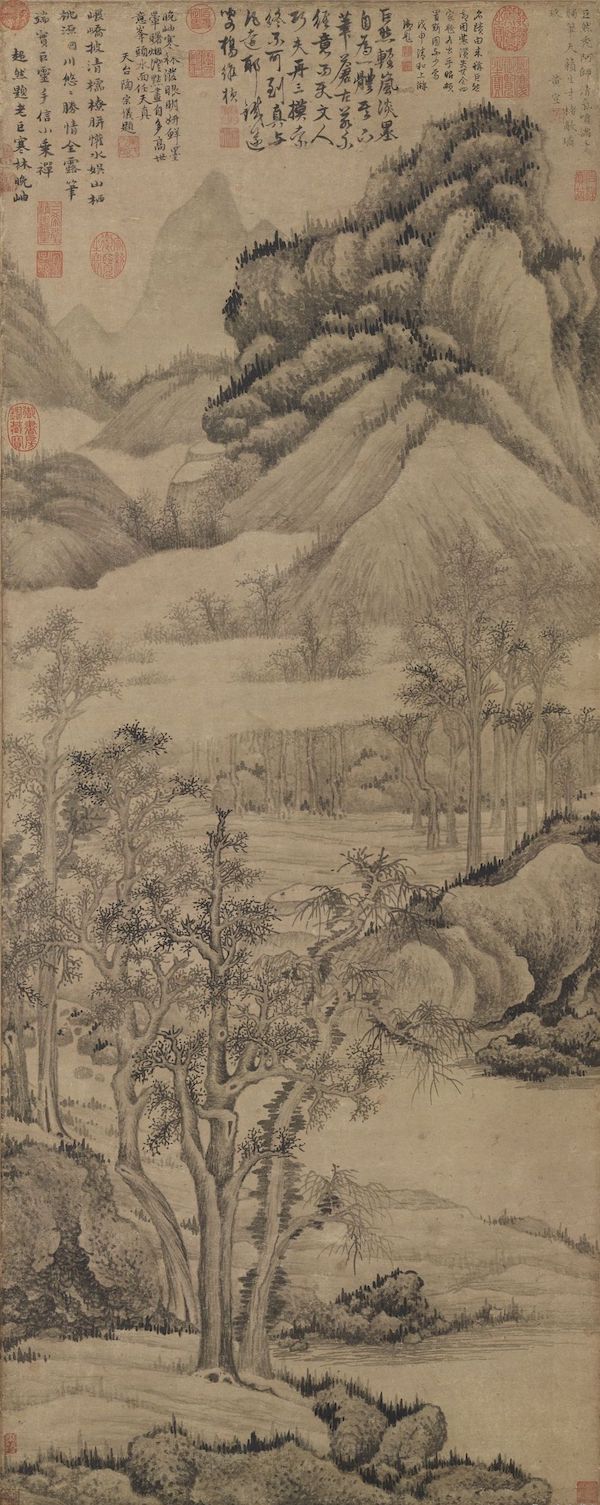
(Biography) Axis of the Five Dynasties and Southern Tang Juran Cold Forest Late Xiu
In this painting, there are mountains and ravines, forests and trees, and the cracked lines of the mountains and rocks are mostly dyed with a wet brush. This painting does not have the author's signature and seal. According to the old signature, it is designated as Juran's work, but the brush and ink are relatively similar to Jiangshen (active in the early 12th century AD). Juran (10th century), born in Zhongling, Southern Tang Dynasty, was a monk of Kaiyuan Temple. After the death of the Southern Tang Dynasty (975), he followed Li Houzhu Yu to the Song Dynasty and went to Bianliang. As a painter of landscapes, he learned from Dong Yuan. He is good at the scene of haze and mist, which is in a wonderful state. He is as famous as his teacher, and he is also called Dong Ju.
(Biography) Song Fachang Sketchbook

(Biography) Song Fachang’s sketchbook (partial)

(Biography) Song Fachang’s sketchbook (partial)
Fachang (about the 13th century), with the common surname Li and nickname Muxi, was born in Sichuan. He is good at painting animals, landscapes, and figures, with simple brushstrokes and no need for decoration.

(Biography) Song Fachang Sketchbook
This scroll is an imitation of Fachang's ink play, with paintings of various flowers, fruits and vegetables, feathers and so on. The sketches of objects seem random, but each flower and leaf are delicate and vivid. First of all, the boneless ink painting of peonies leaves the overlapping parts of the petals and leaves blank. The brush and ink are quite elegant, and it can express new ideas in addition to the styles of various styles.
Qiujiang Yuyin Axis in Wuzhen, Yuan Dynasty

Qiujiang Yuyin Axis in Wuzhen, Yuan Dynasty
Wu Zhen (1280-1354), courtesy name Zhonggui, nicknamed Meihua Taoist, Mei Taoist, Mei Shami, was born in Jiaxing, Zhejiang. His landscape studies of Juran of the Five Dynasties, and his ink and bamboo studies of Wentong in the Song Dynasty can all integrate the strengths of the predecessors and create his own style of painting.
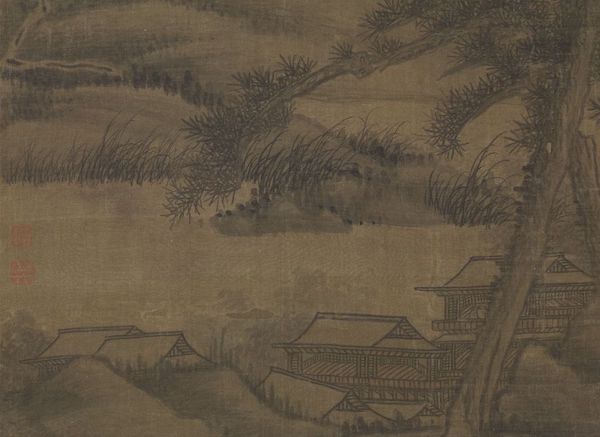
Yuyin Axis of Qiujiang River in Wuzhen, Yuan Dynasty (partial)
This painting depicts a waterfall cascading down from a towering cliff. Among the rocks on Cangshupo, there are village houses and families. In the distance is an empty river and mountains. Only a small fishing boat floats in the middle of the river. The whole painting is mostly painted with a center-point bald brush. The brushwork is calm and powerful, and the dyeing is thick. With the majestic cliffs and tall pine trees, it feels more majestic and heavy.
Ni Zan Maple Falling in Wujiang, Yuan Dynasty
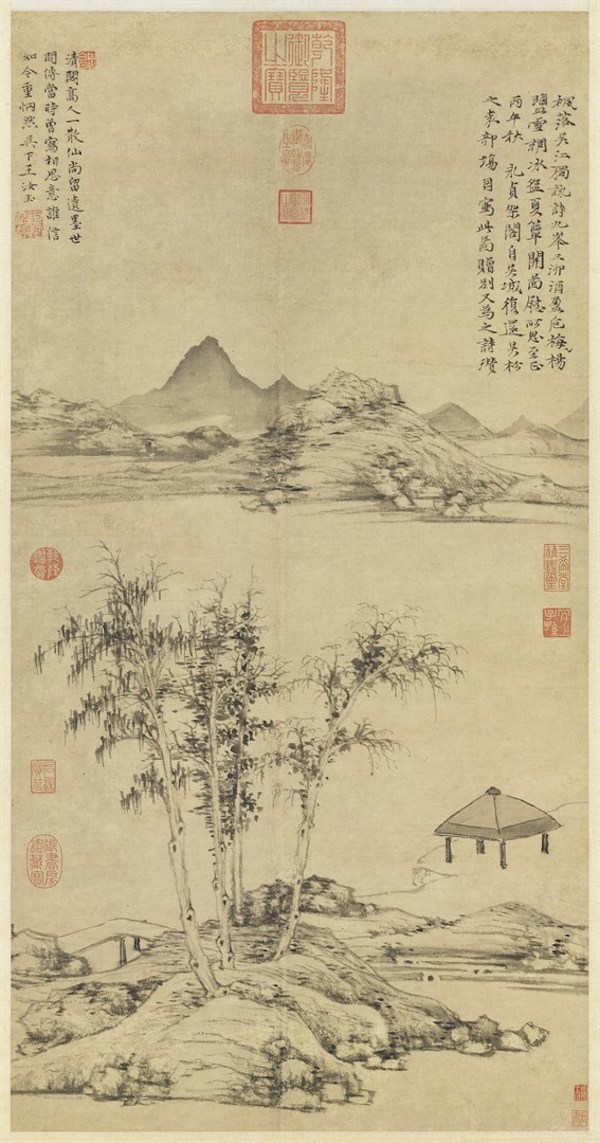
Ni Zan Maple Falling in Wujiang, Yuan Dynasty
Ni Zan (1301-1374) was born in Wuxi, Jiangsu Province, with the character Yuanzhen and the nickname Yunlin and Yuweng. His family background is rich, he built Qing Pavilions, stored ancient calligraphy and paintings, and was especially good at landscapes. He was one of the four great masters in the Yuan Dynasty.
According to its inscription, this painting was written in the autumn of Zhengbingwu (1366), when Ni was sixty-six years old. The composition of the picture adopts the pictorial depiction of the two banks of a river. The tree pavilion faces the water in front and back, and the picture is clear and empty. The slope rocks are depicted with a pen that turns from the center to the side, creating a sense of rock faults. The painting is quiet and the brush and ink are beautiful.
Axis of Yuan Wangmeng's Thatched Cottage in Qiushan
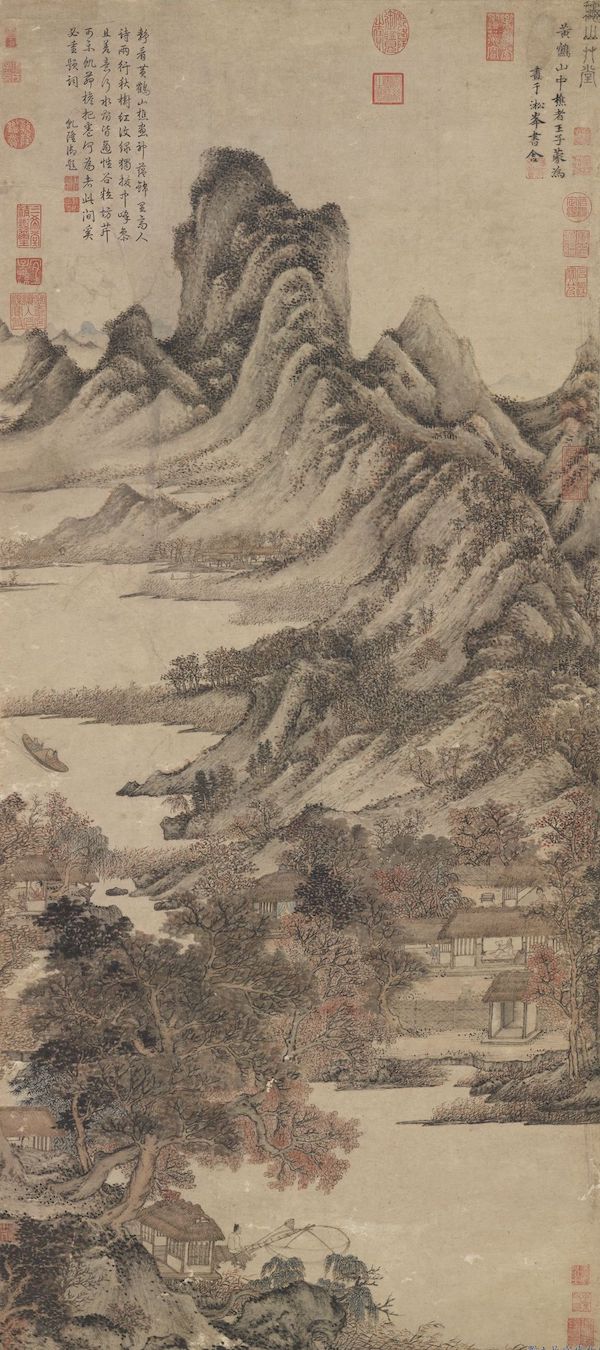
Axis of Yuan Wangmeng's Thatched Cottage in Qiushan
Wang Meng (1308-1385), born in Wuxing, styled Shuming, named Huanghe Shanqiao. Zhao Mengfu's grandson is one of the four great masters of the Yuan Dynasty.
In this picture, the trees on both sides of a stream are interlaced, and the distance between the distance and the nearness is extremely beautiful. The houses in the forest are adjacent to each other, and men and women work and rest. Although they do not seek to be similar in shape, there is a refreshing atmosphere of mountains and forests, which cannot be achieved by engraved descriptions. Backed by mountains stretching far away, wild reed boats and huts in sparse forests lie in between, which is really endless. The brush and ink are elegant and light, and the colors are extremely fine. In the tranquility, I feel that it is ancient, thick and clear.
Ming and Tang Dynasties Shuangpine Waterfall Map Axis

Ming and Tang Dynasties Shuangpine Waterfall Picture Axis
Tang Yin (1470-1523), born in Wu County, Jiangsu Province, was named Bohu and named Liuru. Talented, unrestrained, wild and uninhibited. In the 11th year of Hongzhi (1498), Xie Yuan, the Nanjing provincial examination, was implicated in the bribery case of the Beijing examination, and was relegated as an official. . " Concentrate on studying poetry, calligraphy and painting.
Tang Yin learned painting from Zhou Chen, and was also influenced by Shen Zhou. The brushwork and ink techniques and even the shape of the figure are similar to Shen Zhou's early days, and it is suspected that he painted it before he was 29 years old.
Qing Wang Shimin Floating Lan Warm Cui Shaft

Qing Wang Shimin Floating Lan Warm Cui Shaft
Wang Shimin (1592-1680) was born in Taicang, Jiangsu Province, his style was inferior, his name was Yanke, his grandfather was Wang Xijue, Prime Minister of the late Ming Dynasty, and his father Wang Heng once edited for Hanlin. Wang Shimin, who was born in a family, benefited from his family education and had high attainments in poetry, calligraphy and painting. Under the promotion of his grandfather Wang Xijue, he began to learn from Dong Qichang's sketches at an early age, following Dong Qichang's theory of imitating ancient times in painting. This piece "Floating Lane and Warm Green" imitates Huang Gongwang's painting style, with thick mountains and zigzagging river valleys, which is similar to "Nine Everest Emerald" in composition; the platform mountain suddenly rising on the right is also common in Huang Gongwang's paintings. But the clear contour line on the mountain shows the forward and backward movement of the mountain. In the middle background, the main mountain is left blank as a cloud, and the foot of the mountain is eliminated, forming another mosaic effect. In the contrast between the solid mountain and the empty cloud, there is a unique conflict dynamic. The rows of bushes are drawn between the mountains in the front middle scene, on the one hand, they respond to the mountains, and on the other hand, they also combine with the large and small rocks in the valley to form a rhythmic vitality. In addition, through the use of colors, such as ochre, dark green, etc., to dye the mountain body, although it is an antique, it has already become a new achievement.
Axis of Qiyan Floating Yuanxiu in Qing Dynasty
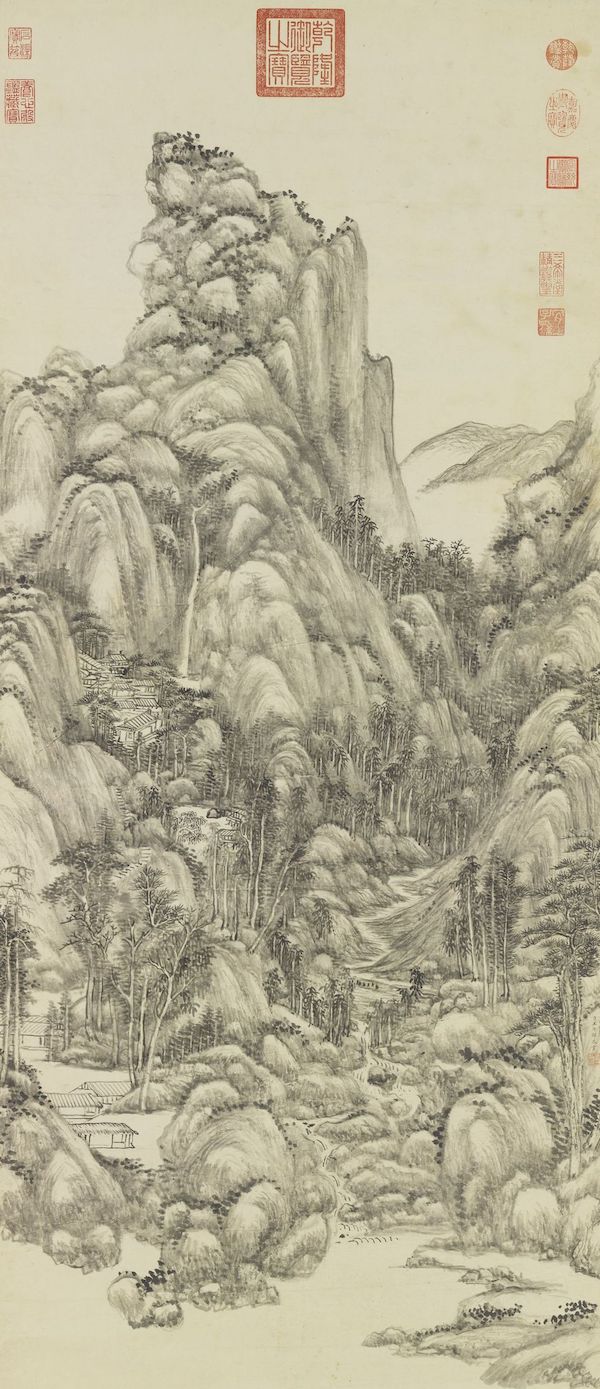
Axis of Qiyan Floating Yuanxiu in Qing Dynasty
Wang Yuanqi, a native of Taicang, Jiangsu (1642-1715), was the grandson of Shi Min. The name is Maojing, the name is Lutai, Jinshi of Kangxi Gengxu, Liguan Shaosinong. Painting was learned by his family, and he was one of the four masters of the Qing Dynasty. This painting is rubbed with ink and wash, only hills and hills are piled up, and the words are thick and thick. The characteristics of Wang Yuanqi's landscape paintings lie in their rigorous structure and boundless realm, and this painting is also worthy of it. This image is undated. According to Wang Yuanqizhong's service to the official center in his later years, every time there was a work that responded to the imperial edict, he was entrusted with the imperial edict at the age of sixty-four to compile the Peiwenzhai calligraphy and painting manual. In addition, he presided over the production of "Longevity Ceremony Picture".
Qing Dynasty Nie Huanghai Wrong Map
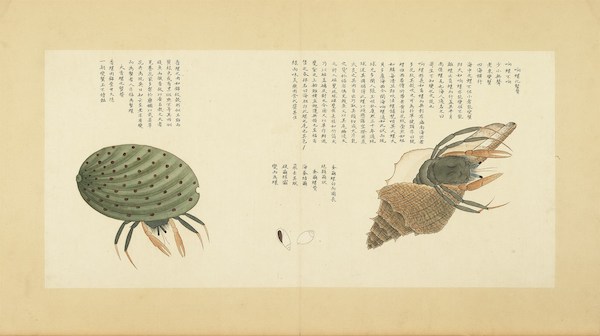
Qing Dynasty Nie Huanghai Wrong Map
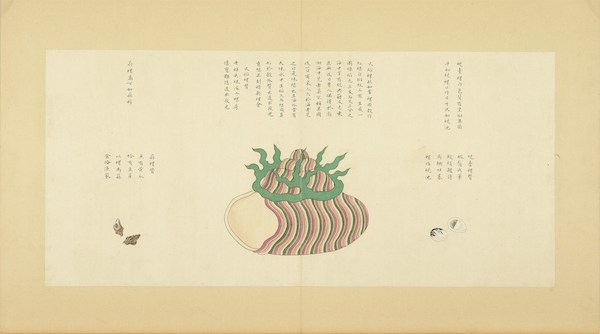
Qing Dynasty Nie Huanghai Wrong Map
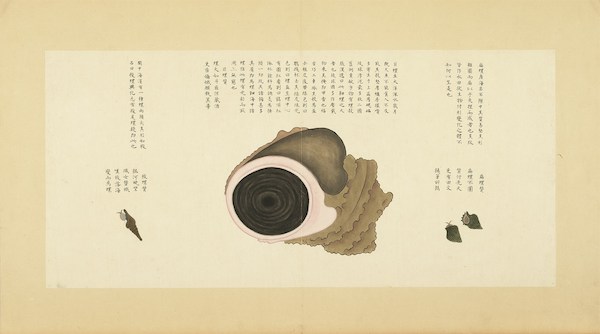
Qing Dynasty Nie Huanghai Wrong Map

Qing Dynasty Nie Huanghai Wrong Map
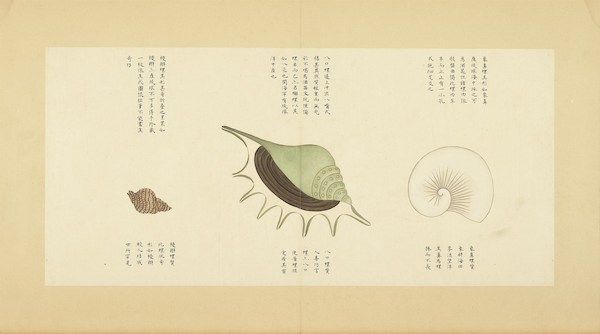
Qing Dynasty Nie Huanghai Wrong Map
There are four volumes of "Hai Cuo Tu" handed down from generation to generation. The preface of the first volume says: "In the midsummer of Kangxi Wuyin (1698), Nie Huangcun'an, a Min guest, inscribed it on Diaoaoji in the sea." Nie Huang, Qiantang (now Hangzhou, Zhejiang) ) people, traveling around the north and south for nearly twenty years. Kangxi Dingmao (1687) once painted "Crab Spectrum", and later transcribed and painted many manuscripts of marine objects he heard and seen into "Haicuo Tu". It is the fourth volume in the collection of the National Palace Museum in Taipei, without a seal. Drawings of sea creatures such as horseshoe crabs, snails, crabs, shrimps, etc., with titles and praises in regular script.
Qing Dynasty Dong Bangda imitated Wang Meng Youlin Qingyi
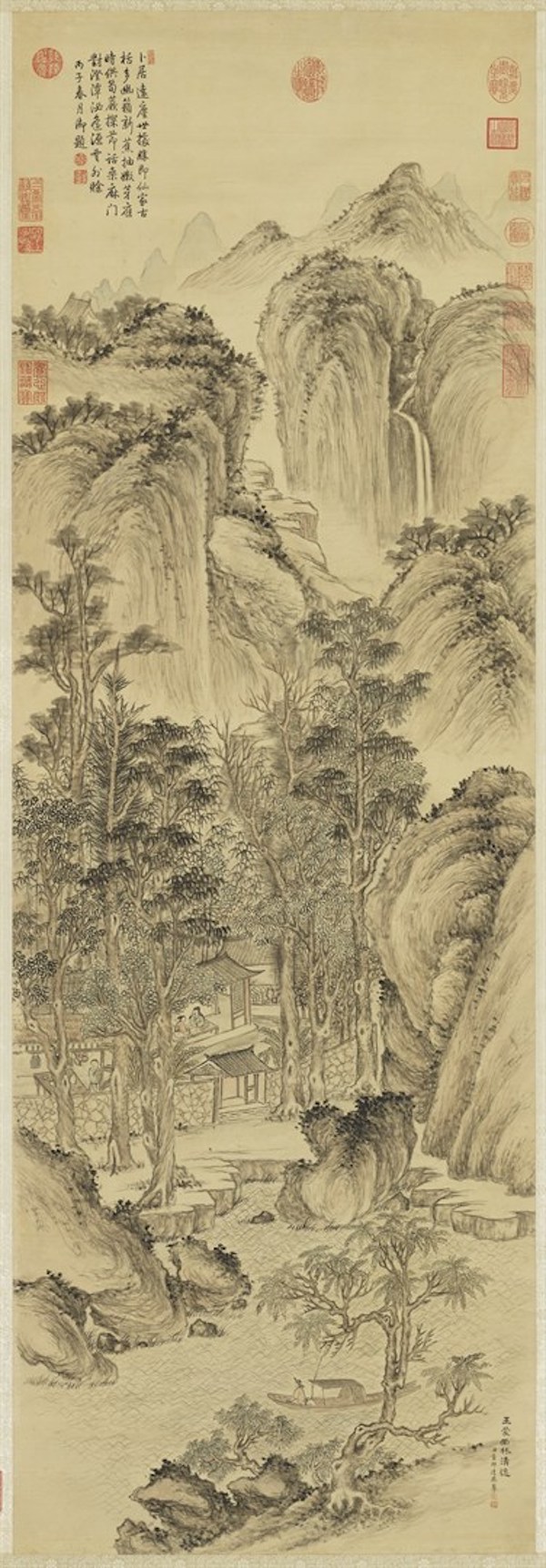
Qing Dynasty Dong Bangda imitated Wang Meng Youlin Qingyi
Dong Bangda (1699-1769) was a representative figure of poet painters in Qianlong Dynasty. His landscape paintings were highly praised by Emperor Qianlong, who compared him with Dong Yuan of the Five Dynasties and Dong Qichang of the Ming Dynasty.
This painting is a copy of Wang Meng's painting "The Quiet Forest and Ease". Comparing the two works, it can be seen that Dong Bangda is generally faithful to the composition and motif of the original work, but the biggest difference lies in the use of brush and ink. The mocha and thick moss in Dong Bangda's paintings are more eye-catching and straightforward than the original works, which shows his strong confidence in interpreting the classic style with mocha.
(This article is compiled based on relevant materials from the National Palace Museum in Taipei.)
